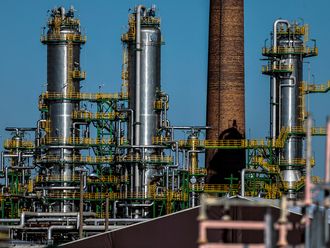Tokyo: Oil traded below $68 (Dh249.76) a barrel as traders assessed mixed supply signals from producers.
Futures in New York were little changed after falling 2.2 per cent last week. Russia suggested on Saturday the country may keep its output at the current level above the Soviet-era record or raise production further, and warned of a potential supply shortage. That’s just days after the Organisation of Petroleum Exporting Countries (Opec) and its allies signalled they could cut output in 2019.
Oil has slumped about 11 per cent from a four-year high earlier this month as a rout in global equity markets raised concerns about economic growth and energy demand at a time of growing US crude inventories. With renewed American sanctions on Iran going into full effect in just a week, traders are looking for signs whether Opec and its partners are able — and willing — to increase production to fill any potential supply gap.
“I expect investors will take a wait-and-see stance this week before the return of sanctions on Iran and US midterm elections,” Makiko Tsugata, a senior analyst at Mizuho Securities Co, said by phone from Tokyo. Despite a potential decline in Iranian exports, “if both Saudi Arabia and Russia boost output and US production continues to rise, we could have a supply glut.”
West Texas Intermediate for December delivery traded at $67.60 a barrel on the New York Mercantile Exchange, up 1 cent, at 12.17pm in Tokyo. The contract rose 26 cents to $67.59 on Friday. Total volume traded was about 15 per cent below the 100-day average.
Brent for December settlement traded at $77.58 a barrel on the London-based ICE Futures Europe exchange, down 4 cents. The contract climbed 73 cents to $77.62 on Friday. The global benchmark crude traded at a $9.96 premium to WTI.
Russian Energy Minister Alexander Novak told reporters in Istanbul he sees no grounds for reducing output and that there are risks of a deficit in oil markets. The nation’s oil production in September rose by almost 150,000 barrels a day to 11.356 million, a post-Soviet high, from a month earlier. The country suggested its output rose further in October.
Similarly, Saudi Arabia said last week the kingdom can further increase its production to ease supply shortfalls even as it has already boosted output to 10.7 million barrels a day, near an all-time high. Energy Minister Khalid Al Falih said Opec and its allies are in “produce as much as you can mode” to meet demand and replace any shortages.
In contrast, a committee of oil producers including Russia and Saudi Arabia highlighted on Thursday the need to prepare “options” for how much crude they should pump next year to prevent the market slipping back into imbalance. The group said the rise in stockpiles, coupled with fears about an economic slowdown “may require changing course” after they have agreed in June to boost production.












